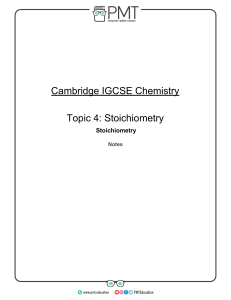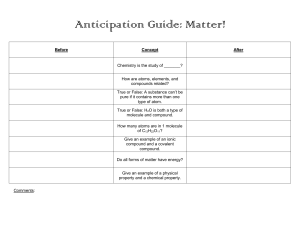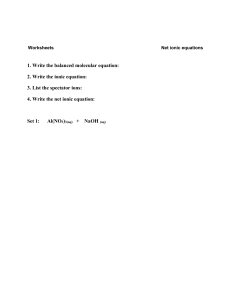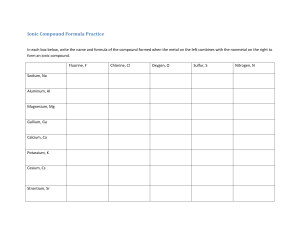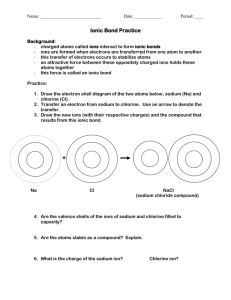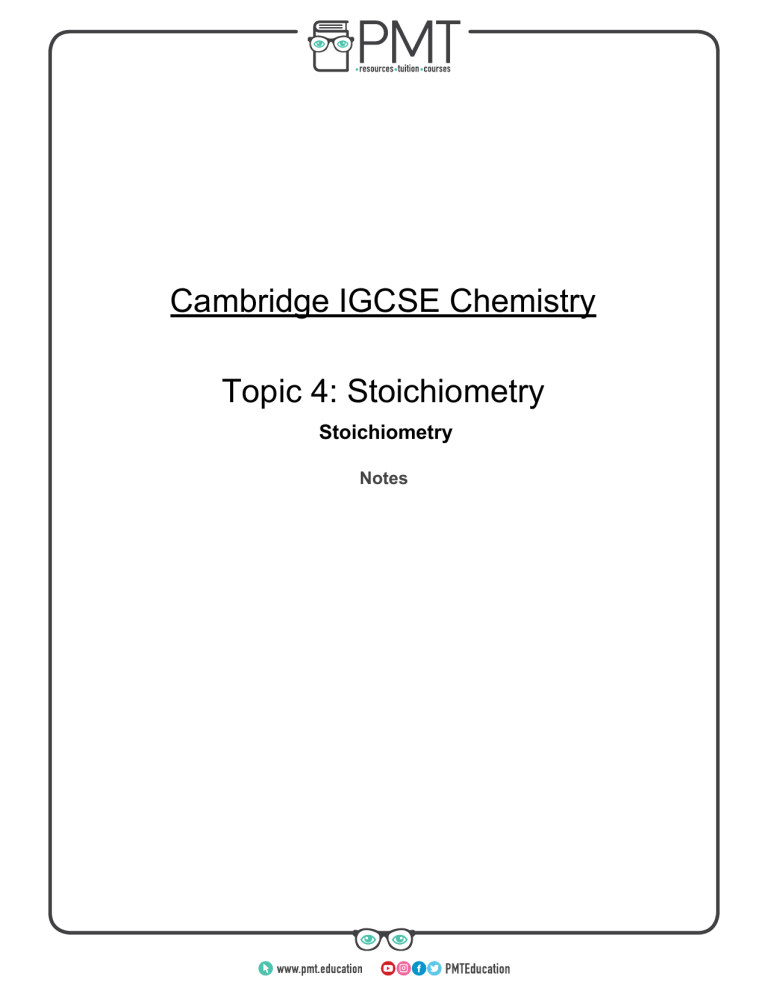
Cambridge IGCSE Chemistry Topic 4: Stoichiometry Stoichiometry Notes www.pmt.education Use the symbols of the elements and write the formulae of simple compounds ● Examples of symbols of the elements: Sodium (Na), Chlorine (Cl) etc… (how they are shown in the periodic table) ● Example of a formula of a simple compound: Sodium chloride (NaCl). (Extended only) Determine the formula of an ionic compound from the charges on the ions present ● To find the formula of simple compounds: o work out what charge ion each element should form o balance out the charges (so they equal zero) by increasing the number of certain elements o write the formula, using little numbers e.g. 2 to show if you have more than one of a certain element ● E.g. Magnesium chloride : o Magnesium forms a Mg2+ ion and chlorine forms a Cl- ion o Therefore, to balance the charges, you need to have 2 x Cl- ions and 1 x Mg2+ ion o MgCl2 Deduce the formula of a simple compound from the relative numbers of atoms present ● for example, if you had 1 atom of aluminium (Al) for every 3 chlorine atoms (Cl), the formula of the compound would be AlCl3 (Extended only) Construct equations with state symbols, including ionic equations ● (g) means gas, (s) means solid, (l) means liquid, (aq) means aqueous ● Example to find an ionic equation: o Start with the balanced chemical equation ▪ HCl(aq) + NaOH(aq) → NaCl (aq) + H2O (l) o Split up (aq) compounds into its ions ▪ H+ + Cl- + Na+ + OH- → Na+ + Cl- + H2O o Cancel out the ions that are the same on either side – known as ‘spectator ions’, leaving the ionic equation ▪ H+ + OH- → H2 O www.pmt.education Deduce the formula of a simple compound from a model or a diagrammatic representation ● work out how many of each different element you have in the compound and then write the formula (remember to use smaller letters 3 to demonstrate how many of each element you have) (Extended only) Deduce the balanced equation for a chemical reaction, given relevant information ● Must have the same amount of atoms on either side of the equation i.e. if 2Na react, then there must be 2Na that are produced, this includes something like 2NaCl ● to write a balanced equation: o write out the unbalanced equation using symbols for reactants and products e.g. H2 + Cl2 → HCl o count up how many of each element you have on the reactant and product side of the equation. ▪ for H: 2 on reactant, 1 on product ▪ for Cl: 2 on reactant, 1 on product o use large numbers at the front of formulas to balance out the numbers of atoms of elements so they are the same on both sides ▪ H2 + Cl2 → 2HCl o add state symbols ▪ H2 (g) + Cl2 (g) → 2HCl (aq) Construct word equations and simple balanced chemical equations ● Example of word equation: hydrochloric acid + sodium hydroxide → sodium chloride + water ● Example of balanced chemical equation: HCl + NaOH → NaCl + H2 O Define relative atomic mass, Ar, as… ● The average mass of naturally occurring atoms of an element on a scale where the 12C atom has a mass of exactly 12 units Define relative molecular mass, Mr, as… ● The sum of the relative atomic masses ● Relative formula mass or Mr will be used for ionic compounds. www.pmt.education
